Yes, I’ve written and illustrated an entire blog post about dead insects. It’s a little morbid, but also fascinating, and often beautiful. Plus, it’s my blog and I can write about whatever I want. You’re not obligated to read it, though I would if I were you – there are some intriguing stories included.
Photographing insects is a lot easier when they’re not moving. It’s one reason I love early summer mornings when the dew is heavy and the small creatures are held in stasis by cool temperatures and a covering of sparking water droplets. There is another situation, of course, when insects are holding still and are easy to photograph.
It’s when they’re dead.
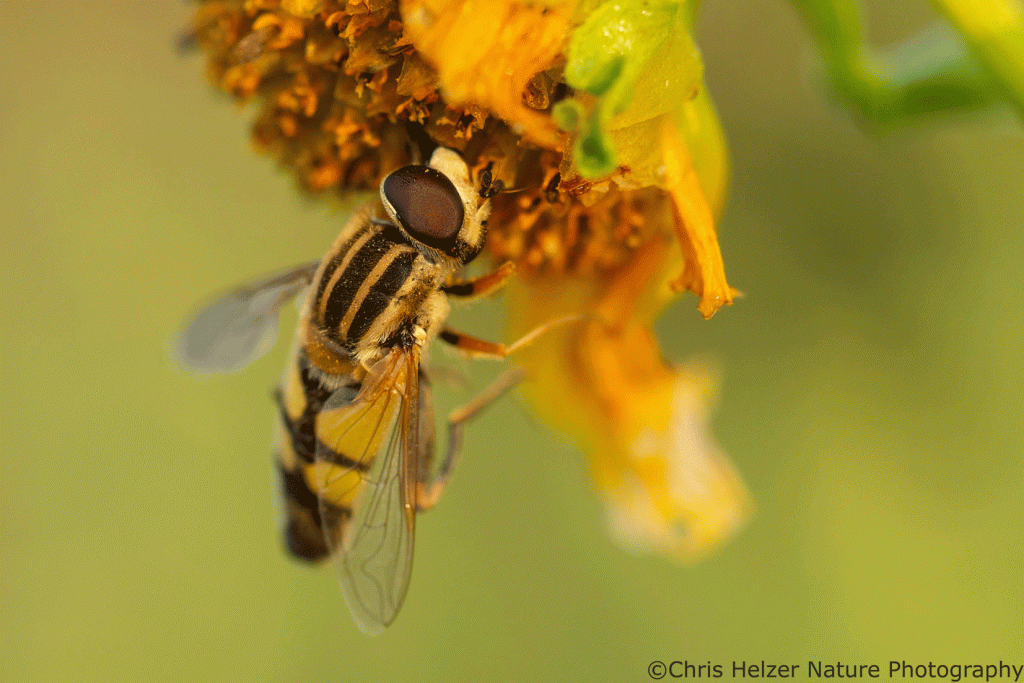

It’s not that I photograph dead insects and try to pass them off as living. Even among recently-deceased creatures, there are tell-tale signs (curled up legs or antennae, for example) that reveal the truth. There are really three reasons I will stop and photograph them: 1) there’s an aesthetic beauty that strikes me; 2) there is a mystery behind the death; 3) there’s a good story involved.
(As always, these photos will look better if you click on them individually to see a bigger version. If you’re reading this in your email, you’ll need to click on the title at the top to open it online and allow you to click images.)
The following two photos are examples of the aesthetic beauty factor, but with a little mystery thrown in. I found a bunch of dead millipedes along the edge of the pond at our family prairie, for example. They were faded enough that they’d clearly been dead for a while, but I couldn’t tell why. Had they drowned and then been stranded as the water receded? I don’t know, but there were a lot of them and I found a curled one that was pleasingly-placed against a backdrop of cracked, drying mud.
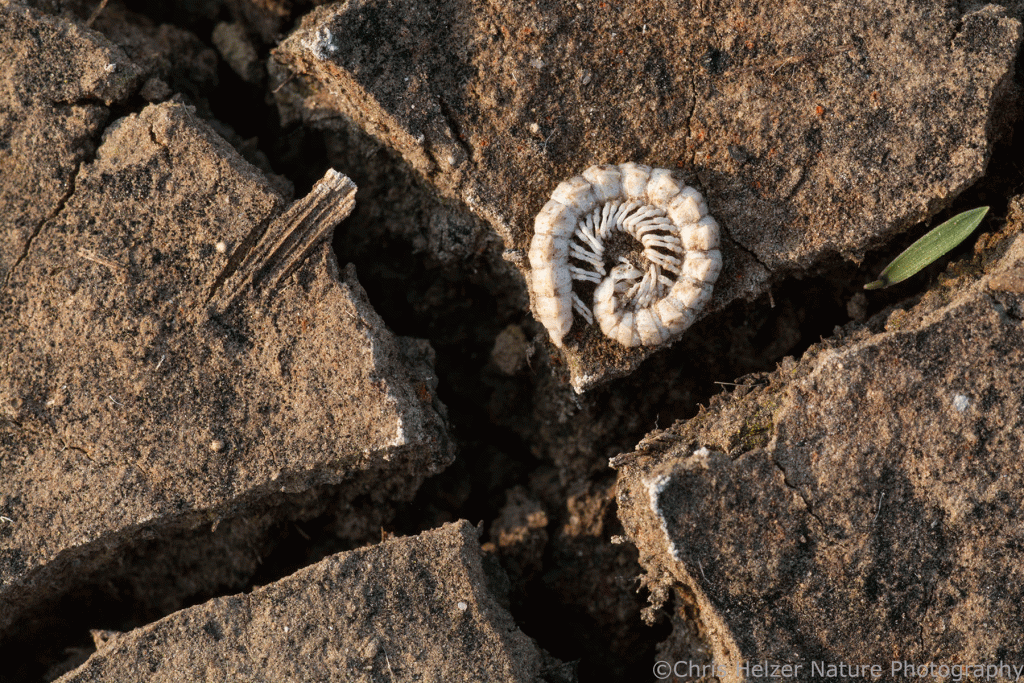
In the same stretch of drying shoreline, I also found a mostly intact dragonfly corpse. Again, it wasn’t clear how it had died, but I liked the almost monochromatic scene, so I stopped to photograph it. In neither case did I have to worry about the subject trying to fly, hop, or skitter away.
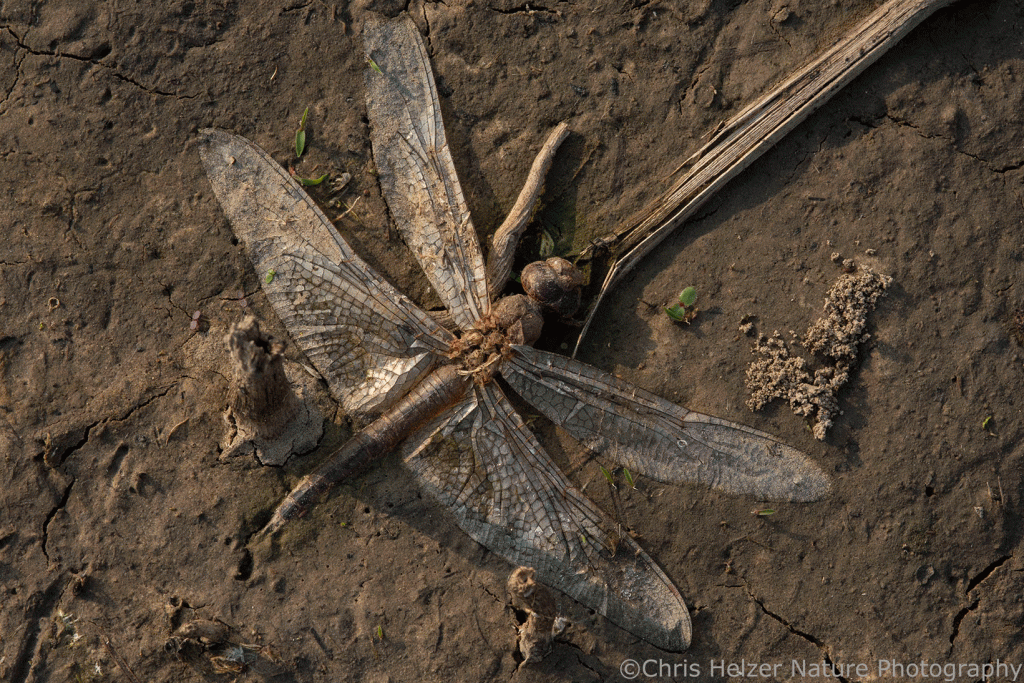
Sticking with the ‘mystery’ category, I photographed the pill bug (aka sow bug, roly-poly, etc.) back in 2017 after finding a whole bunch of them scattered across a prairie we’d recently burned. I wrote a post at the time, in which I pondered the possibilities for what I was seeing. I still don’t have a good solution to the mystery, but it’s fun to think about. Also, the bleached white skeleton of a pill bug has a certain aesthetic charm to it.

One of the most intriguing dead insect findings I’ve had was at our family prairie back in September 2020 when I happened upon hundreds of Virginian tiger moth caterpillars (Spilosoma virginica). I saw a bunch feeding on plants one week, and then when I returned a week later, many of them had climbed high into the canopy of the prairie and died. I hypothesized that it could have been caused by a fungus or parasitoid, but didn’t – and still don’t – have a solid explanation.


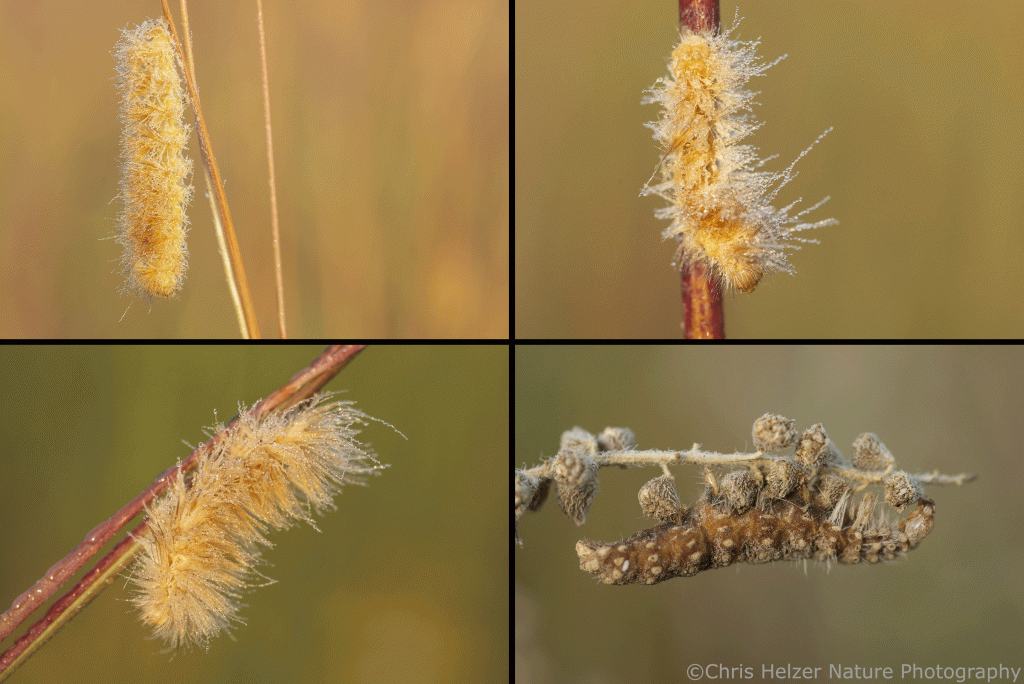
Dead insects aren’t always a mystery. Sometimes, I feel pretty confident about the reasons for their demise. That’s the case with all the remaining dead bug photos I’m sharing today. The first is a fly I found floating dead in the water trapped by the leaves of a cup plant (Silphium perfoliatum). I’m reasonably sure the fly drowned in the water. I’ve not found any source of information that provides any reason the plant might benefit from drowning small creatures, but it does seem to be a periodic side effect.

I’ve written previously about the seemingly illogical strings of events that have to happen for milkweed plants to be pollinated. As part of that process, insects accidentally slip a leg into milkweed flowers and then have to extract themselves again. Sometimes, that doesn’t work out well and someone gets stuck and ends up dying awkwardly right there. The photo below shows a bee that died in just that way.

Speaking of plants killing insects in (probably) accidental ways, there are two other examples of that, from which I have gotten many opportunities to photograph insects holding permanently still. The first is a fascinating phenomenon, in which insects get often stuck to the bracts of thistle flowers and die. Those bracts become very sticky before and during the time the flowers bloom, and there are multiple hypotheses about why this happens.
Does it serve a purpose to the plant when ants (largely) and other insects become trapped on those bracts? Maybe. The research I’m aware of is inconclusive. Also, not all invertebrates are vulnerable. Some (stink bugs, for example) seem to be able to walk across the bracts with no consequences.


Another plant species that makes itself sticky enough to trap insects is one that I’ve not seen other people comment on. Illinois tick-trefoil (Desmodium illinoense) seems to exude a sticky substance from hairs on its stems during part of its life cycle, and those hairs then trap insects. I’ve seen this a couple times at Lincoln Creek Prairie here in Aurora but haven’t yet seen it elsewhere. I’d love to hear from anyone else who has seen this, either with this tick-trefoil species or others. I’d also welcome any hypotheses about why this might be something useful to the plant.

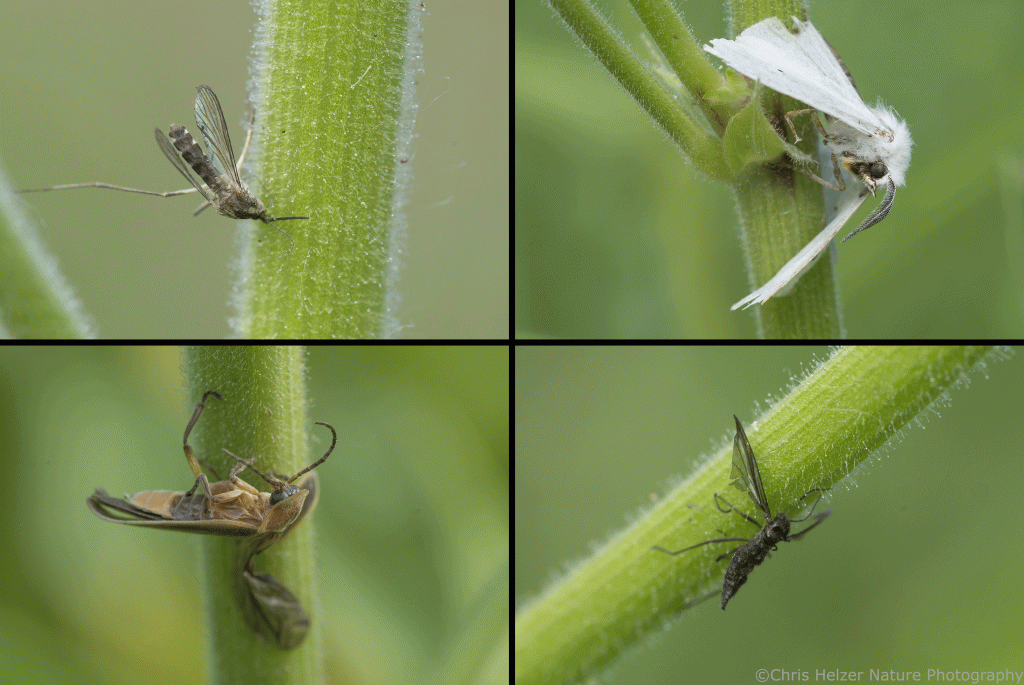
I’ll end with a subject that won’t surprise long-term readers of this blog, which is insects killed by crab spiders – one of my very favorite invertebrates. Often, the spider holding (and feeding on) an insect is well-enough camouflaged that I don’t immediately see it. I just see an insect, often in an odd position, on or near a flower, and then spot the spider when I get closer. Crab spiders are very good at what they do.


I recognize that a whole blog post about dead bugs is a little odd. I hope, though, that if you made it this far, you feel rewarded by either the beauty of the images or the intrigue of the stories – or both. There’s a lot to be learned from observation, and that includes observation of dead creatures. Plus, in case you missed it earlier, deceased insects are easy to photograph.
…………
This post is dedicated to the memories of all the insects that died to make the photographs and stories I’ve shared. Their lives were short, but that’s kind of the thing with insects anyway. Some obviously died at the hands (or whatever) of others (like crab spiders and whatever killed those caterpillars). Others seemed to die accidentally. Even those accidental deaths, though, weren’t wasted within the ecosystem. Something eventually consumed all the dead insects pictured here, even if it was something microscopic like bacteria.

That was fantastic. Thanks!
Great post! I love dead critters too. Your mystery critter on the tick-trefoil looks like a Glowworms (Phengodes). Check out BugGuide. https://bugguide.net/node/view/50541/bgimage
Thanks!!
Your picture of the delightful creature with the feathery antennae is an adult male glow worm beetle. Enchanting! Phengodes sp. – Glowworm Beetle – Phengodidae (texasento.net) https://www.texasento.net/Phengodes.htm Donna Hughes
I don’t have the collection you have, but I have quite a few photos of dead insects as well. It usually starts that I am surprised they are letting me get so close. Then, I notice something is not right about them. Other times they are obviously dead, but in a curious way.
I have a bumble bee that is missing a head, but the whole body is intact. I have a photo of a mostly black monarch butterfly caterpillar. I have several that appear to have been killed by cordyceps fungi, but they are gone by the time I return to see the fruiting bodies (someone told me the twisted head while frozen on a perch is a characteristic cordyceps fungi death, but that may not be true). One of the more interesting was last summer watching multiple syrphid flies die from accidentally running into a sweat bee stinger on a busy coreopsis flower. At first I thought it may have been a display of territoriality to exclude the other pollinators, but after watching closely it looked more like clumsiness. Those little sweat bee stings can induce a little welt on a human, so I guess they can be deadly if you are 1/1000th the size.
I guess this just shows what nerds we all are, because I have a collection of dead insect and other small critter pictures, too. Love all that you’ve given us to ponder here.
I too have seen dead insects on Desmodium illinoense but don’ t have any photos nor do i remember what they were. I do remember being fascinated for the prospect of the plants’ stickiness and trying to figure out why it has that adaptation. This was at Prairie State Park in southwest Missouri.
if studying this is odd, i don’t want to be even. another great post!
Chris,
Your post reminded me of a recent post of someone I follow on instagram. Here it is.
Cheers,
Paul
Chris, I also love it when I get the chance to photograph dead insects. I think a possible explanation for those Virginian tiger moth caterpillars might be the baculovirus — it makes them climb to the tops of stems before they die, helping to further the spread of the virus. Article at https://www.science.org/content/article/how-virus-turns-caterpillar-zombie.
That could be right, though I thought that virus ended up liquefying the caterpillars and these looked like they were becoming desiccated.
It appears to be a Pterotus lightning beetle missing its elytra.
Hi Prairie Ecologist,
<
div>I loved your dead bug chronicles! I didn’t think it was weird, but, I mean, it’s all
I love these posts so much. It’s so nice to see someone else fascinated by insects, even dead ones!
Have a great day.